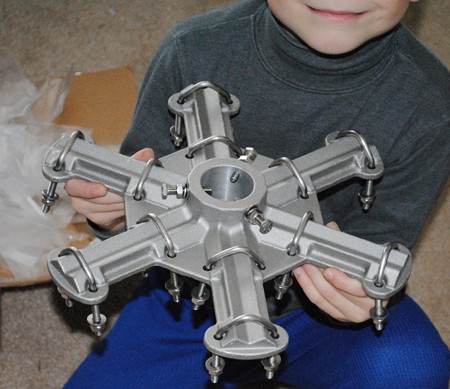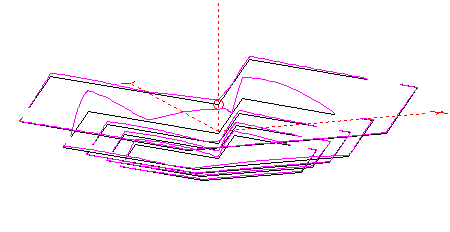It seems the hexagonal beam has come of age as multiple manufacturers square off in an attempt to claim market share of the growing market for this style of antenna.
Ever since the 2009 QST article many folks, myself included, became aware of the simple elegance of the Hexagonal Beam (also known as Hexbeam generally and Hex-Beam® by Traffie Technology).
Indeed the simulated and reported performance of these Hex Beam antennas appears to be quite reasonable for the size. The “hex-beam” group on Yahoo has been buzzing away with discussion.
Originally an organization called “Traffie Technology” offered Hex-Beam products.
Another vendor came along with parts and kits for DIY hex beams at HexKit.com.
Then the QST article in early 2009, written by K4KIO, highlighted a different topology inspired by G3TXQ where the size of the frame and arrangement of the wires differ from the classic Hex-Beam to yield more broadband performance on each of the 20-10 meter bands with the burden of slightly larger size.
Each Hexbeam “style” is covered in superb detail at G3TXQ’s web site…
So the hex beam nuts had two choices of hex beam products: The Classic Hexbeam from Traffie Technologies and the Broadband Hexbeam created by G3TXQ and offered by K4KIO.
One of my favorite amateur radio companies, DX Engineering, came out with their own kit version of the broadband hex beam design called the Hexxagonal Beam.
So now we have four major suppliers of hexbeam kits and/or parts…
- Traffie Technology with the HEX-BEAM®
- HexKit
- K4KIO with the G3TXQ Broad band Hexagonal Beam
- DX Engineering with their HEXXAGONAL BEAM (a version of the G3TXQ)
The various names are humorous. Only Traffie Technology has a registered trade mark on HEX-BEAM®. DX Engineering is trying to claim trade mark on HEXX and HEXXOGONAL using Copyrights which is a bit bizarre. K4KIO discusses trademarks/copyrights on his site very briefly. Two of the three web sites reveal a surprising lack of understanding of what Copyrights and Trademarks are. Oh well.
With four competitors in the Hex Beam supply biz, I suggest the Hex Beam has arrived. These companies know you are out there and are competing for your antenna dollars. Traffie Technology offers the original smaller hex beam where both the driver and reflector are in the shape of a W; Traffie’s web site has a tech section which may suggest the Traffie version is not the classic, but something slightly different and more broad banded. K4KIO has the terrific QST article bringing attention to the G3TXQ broadband design. DX Engineering provides an excellent engineering background to the G3TXQ design stemming from their years of many well engineered antenna products; They have a spiffy new approach to the center base plate.
Look at each of their web sites and you will see the points they make in an attempt to win you over. This has better engineering… This has fewer parts… This has longer history… etc.
Note about Antenna Simulations
Note that some of the suppliers above, and many amateur radio antenna manufacturers in general, argue their antenna designs are not possible to simulate correctly in today’s NEC and other programs. Traffie mentions this on his tech page. Arrow Antennas told me the same thing for something as simple as their 440 MHz Yagi beam claiming no simulation works for their antenna.
Simulation has its limits and the lower cost versions of the available NEC programs often don’t have enough elements to properly model up something like the hex beam antenna, but it can be done with the more capable versions.
If an antenna manufacturer suggests simulations don’t match reality they either don’t understand reality, don’t understand simulations or are hiding something. No modern antenna engineering is performed without simulations (and of course real testing) these days. Antennas far more complex than any seen in amateur circles, including the hex beam, are successfully designed on the computer first with great success. Any manufacturer thinking their design can fool a competently modeled simulation of same is suspicious.
This does NOT mean these manufacturers don’t produce good quality results as hard core experimentation can and does work. Edison was weak on theory, but strong on trying everything experimentally; Edison experimented his way to success on several projects. However, Tesla was strong on theory. Tesla’s AC power system won the battle against Edison’s DC power system even before the first wire was laid down.
The point is Antenna Engineers howl at the idea any amateur antenna has supernatural powers that thwart decades old simulation abilities.
Its all good news though
The good news is the Hex Beam directional antenna in almost any form gives good performance in a compact package. In the end, we are the real winners. Go get you one…

